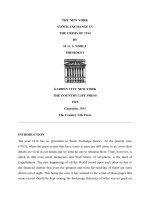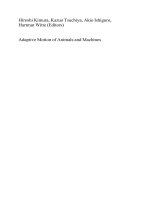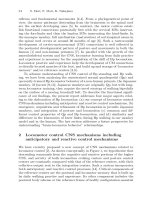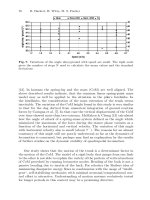Blanchard et al (eds ) in the wake of the crisis; leading economists reassess economic policy (2012)
Bạn đang xem bản rút gọn của tài liệu. Xem và tải ngay bản đầy đủ của tài liệu tại đây (3.67 MB, 251 trang )
In the Wake of the Crisis
In the Wake of the Crisis
Leading Economists Reassess Economic Policy
edited by Olivier Blanchard, David Romer,
Michael Spence, and Joseph Stiglitz
The MIT Press
Cambridge, Massachusetts
London, England
© 2012 International Monetary Fund
All rights reserved. No part of this book may be reproduced in any form by any electronic
or mechanical means (including photocopying, recording, or information storage and
retrieval) without permission in writing from the publisher.
Nothing contained in this book should be reported as representing the views of the IMF,
its Executive Board, member governments, or any other entity mentioned herein. The views
expressed in this book belong solely to the authors.
MIT Press books may be purchased at special quantity discounts for business or sales
promotional use. For information, please email or write to
Special Sales Department, The MIT Press, 55 Hayward Street, Cambridge, MA 02142.
This book was set in Sabon by Toppan Best-set Premedia Limited. Printed and bound in
the United States of America.
Library of Congress Cataloging-in-Publication Data
In the wake of the crisis : leading economists reassess economic policy / edited by
Olivier Blanchard . . . [et al.].
p. cm.
Conference proceedings.
Includes bibliographical references and index.
ISBN 978-0-262-01761-9 (hardcover : alk. paper)
1. Global Financial Crisis, 2008–2009—Congresses. 2. Fiscal policy—Congresses.
3. Monetary policy—Congresses. 4. Economic development—Congresses. I. Blanchard,
Olivier.
HB37172008.I6 2012
339.5—dc23
2011040553
10 9
8
7
6 5
4
3
2
1
Contents
Preface ix
I
Monetary Policy
Questions: How Should the Crisis Affect Our Views of Monetary
Policy? 3
1
Monetary Policy in the Wake of the Crisis 7
Olivier Blanchard
2
Conventional Wisdom Challenged? Monetary Policy after the
Crisis 15
Guillermo Ortiz
3
Lessons for Monetary Policy
Otmar Issing
4
Macroeconomics, Monetary Policy, and the Crisis 31
Joseph Stiglitz
II
25
Fiscal Policy
Questions: How Should the Crisis Affect Our Views of Fiscal
Policy? 45
5
Fiscal Stimuli and Consolidation 49
Parthasarathi Shome
6
What Have We Learned about Fiscal Policy from the Crisis? 57
David Romer
vi
Contents
7
Fiscal Policy Responses to Economic Crisis: Perspectives from an
Emerging Market 67
Sri Mulyani Indrawati
8
Fiscal Policy 73
Robert Solow
III Financial Intermediation and Regulation
Questions: How Should the Crisis Affect Our Views about Financial
Intermediation and Regulation? 79
9
Financial Crisis and Financial Intermediation: Asking Different
Questions 83
Y. V. Reddy
10
Global Liquidity 91
Hyun Song Shin
11
Optimal Financial Intermediation: Why More Isn’t Always
Better 101
Adair Turner
12
Process, Responsibility, and Myron’s Law
Paul Romer
IV
Capital-Account Management
111
Questions: How Should the Crisis Affect Our Views of CapitalAccount Management? 127
13
Notes on Capital-Account Management 129
Ricardo Caballero
14
Remarks on Capital-Account Management and Other
Macropolicy Topics 133
Arminio Fraga
15
Capital-Account Management: Key Issues 137
Rakesh Mohan
16
The Case for Regulating Cross-Border Capital Flows
José Antonio Ocampo
145
Contents
V
vii
Growth Strategies
Questions: How Should the Crisis Affect Our Views of Growth and
Growth Strategies? 153
17
Do We Need to Rethink Growth Policies? 157
Dani Rodrik
18
Is the Chinese Growth Model Replicable? 169
Andrew Sheng
19
Growth in the Postcrisis World
Michael Spence
175
VI The International Monetary System
Questions: How Should the Crisis Affect Our Views of the
International Monetary System? 187
20
The Implications of Cross-Border Banking and Foreign-Currency
Swap Lines for the International Monetary System 191
Már Guðmundsson
21
The International Monetary System 199
Olivier Jeanne
22
International Monetary System Reform: A Practical Agenda 209
Charles Collyns
23
Liquidity and the International Monetary System 215
Maurice Obstfeld
Concluding Remarks 225
Olivier Blanchard
List of Contributors 229
Index 233
Preface
As a world economic crisis developed in 2008 and lasted longer than
most economists predicted, it became increasingly clear that beliefs about
macroeconomics and macroeconomic policy needed to be thoroughly
examined. In the throes of the crisis, policymakers had to improvise.
What should be done when interest rates reach the zero floor? How is
liquidity best provided to segmented financial institutions and markets?
How much should fiscal policy be used when starting from high levels
of debt?
After the initial fires were put out, many questions remained. Is inflation targeting the right way to conduct policy, or should the monetary
authority watch a larger set of targets? Should central bankers develop
and use new tools, so-called macroprudential instruments? Could fiscal
policy be used more efficiently? Were the precrisis targets for public debt
the right ones? Should there be limits on current-account imbalances?
Should countries use capital controls? Should there be better mechanisms
to deliver global liquidity? What, if anything, can policymakers do to
turn anemic recoveries into robust ones?
We at the International Monetary Fund badly needed answers or at
least beginnings of answers to these questions. To begin the process,
David Romer, Michael Spence, and Joseph Stiglitz helped me organize a
conference at the IMF on March 7–8, 2011, for prominent academics
and policymakers. We organized the Conference on Macro and Growth
Policies in the Wake of the Crisis around six themes—monetary policy,
fiscal policy, financial regulation, capital-account management, growth
strategies, and the international monetary system. For each theme, David
and I wrote a short note that listed some questions on the topic. We
asked for views on these themes, not for formal papers. The conference
x
Preface
proceedings are published in this book. They include the notes we wrote
for each session, the contributions from the panelists, and my concluding
remarks.
By the end of this fascinating conference, we knew that we had
entered a brave new world and that the crisis is generating enough questions to fill our research agendas for years to come. It will take many
years to uncover the answers. I am hopeful that this book contributes to
the journey.
Organizing a major conference, getting very busy authors to write
their contributions in time, correcting their mistakes in style and thinking, and getting the book out less than a year after the conference took
place is a remarkable achievement. We are deeply thankful to Tracey
Lookadoo and her team at the IMF for organizing the conference, to the
MIT Press for going all-out to deliver on time, and especially to Josh
Felman for his contribution from beginning to end.
Olivier Blanchard
I
Monetary Policy
Questions: How Should the Crisis Affect
Our Views of Monetary Policy?
Precrisis Consensus
The years before the world economic crisis began in 2007 and 2008 saw
the emergence of a consensus view of monetary policy. It went roughly
like this:
1. Flexible inflation targeting provides a sound framework for monetary
policy.
2. The supervisory and macroeconomic aspects of monetary policy can
be largely separated.
3. Departures of asset prices from fundamentals are hard to detect in
real time, and the contractionary effects of sharp falls in asset prices can
be greatly mitigated by monetary easing. As a result, asset prices should
affect monetary policy only to the extent that they help predict goods
price inflation and the output gap.
4. The zero lower bound on nominal interest rates is a minor issue. It is
rarely encountered, and its consequences are likely to be modest when
it is. Moreover, policymakers have powerful tools (such as targeting
long-term rates and temporarily raising their inflation target) that they
can use if it becomes a major constraint.
5. Monetary policy and fiscal policy are linked in the long run through
the government budget constraint, but in the medium run they should
and can be kept largely separate.
Postcrisis Issues Related to the Precrisis Consensus
The crisis and the policy responses to it have raised concerns about each
of these ingredients of the consensus view. Taking them in reverse order:
4
Part I
5. To what extent have policy actions in the crisis—such as special
lending facilities, measures to prevent the disorderly failure of particular
financial institutions, and actions to support sovereign debt—blurred the
lines between monetary and fiscal policy? Are such actions a mistake?
Are they necessary in extreme circumstances? Should they be a standard
part of the monetary policy toolkit?
4. Has the zero lower bound been an important constraint in the crisis?
Does the failure of central banks to adopt some of the precrisis ideas for
dealing with the zero lower bound reflect drawbacks of those ideas that
were not understood by their proponents, or does it reflect excessive
caution or lack of concern about unemployment on the part of policymakers? Should any of those ideas be adopted now? Should central
banks adopt higher inflation targets when the crisis has passed? Should
they target a price-level path or a path of nominal gross domestic
product?
3. Should interest-rate policy respond to asset prices? If so, what asset
prices—and what types of movements in those prices—should affect
policy? Should central banks take a more ecumenical view of monetary
policy, thinking not only of the policy rate but also of margin, reserve,
downpayment, and capital requirements jointly as the tools of macroeconomic and financial stabilization policy (as many of them once were)?
2. Is it important for central banks to play a major role in financial
supervision? Should changes in capital requirements and related tools be
coordinated with interest-rate policy? Can regulation of systematic risk
and supervision of idiosyncratic risk be separated? If central banks
use a larger set of tools beyond the policy rate, can full central-bank
independence be preserved, or does it need to be redefined?
1. Is inflation targeting the right framework going forward? Is the socalled divine coincidence result that stable inflation implies a stable
output gap a reasonable approximation, or should central banks explicitly care about the output gap? And if so, how? Also, even when they
claim to follow an inflation-targeting strategy, central banks in many
emerging economies clearly care about exchange-rate movements
beyond their effect on inflation. Many of them use the policy rate and
manage their reserves to smooth their exchange rate. Are they right
to do so?
Monetary Policy
5
Other Issues Raised by the Crisis
Some other issues concerning monetary policy raised by the crisis:
1. Do large expansions of central-bank balance sheets pose a significant
risk of inflation? If so, through what channel: A largely conventional one
of losing sight of the inflation objective and of long and variable lags?
A loss of confidence in central banks and a consequent unmooring of
inflation expectations? Capital losses on central banks’ balance sheets
and a resulting loss of independence?
2. Is there any truth to the claim that central banks responded much
more aggressively and creatively to disruptions in financial markets than
to the prospect of years of high unemployment? If so, was this appropriate? And if it did occur and was not appropriate, why did it occur?
3. Do the increasingly precarious fiscal positions of many countries
threaten central-bank independence?
4. How has the crisis changed the importance of international coordination in monetary policy? For example, swap lines and other arrangements
among central banks were important during the crisis. And at the zero
lower bound, a central bank cannot easily offset the aggregate demand
effects of other countries’ exchange rates or trade policies. Do these
observations have important implications going forward?
5. Should central banks change their communication policies substantially as a result of the crisis?
1
Monetary Policy in the Wake of the Crisis
Olivier Blanchard
Before the economic crisis began in 2008, mainstream economists and
policymakers had converged on a beautiful construction for monetary
policy. To caricature just a bit: we had convinced ourselves that there
was one target, inflation, and one instrument, the policy rate. And that
was basically enough to get things done.
One lesson to be drawn from this crisis is that this construction was
not right: beauty is not always synonymous with truth. There are many
targets and many instruments. How the instruments are mapped onto
the targets and how these instruments are best used are complicated
problems, but we need to solve them. Future monetary policy is likely
to be much messier than the simple construction we developed earlier.
Figure 1.1 shows the way that monetary policy was seen in advanced
countries before the crisis. There was one target, stable inflation, and
there was one instrument, the policy rate or more precisely the policy-rate
rule, and that was basically enough. If you had the right rule for the
policy rate, you would achieve low and stable inflation. The use of a rule,
implicit or explicit, gave the central bank credibility and delivered a
stable economy.
The implicit assumption was that stable inflation would deliver
economic stability in the sense of a stable output gap. This was the
case in many formal academic models, particularly in the benchmark
new Keynesian model, which displayed a property that Jordi Gali and I
have called the “divine coincidence.” In these models, if you maintained
stable inflation, you would also maintain a stable output gap. The
two went together, so there was no reason to look at the output gap
separately.
8
Olivier Blanchard
Stable
inflation
(≈
Stable
output gap
)
Inflation targeting
Policy-rate
rule
Figure 1.1
Precrisis orthodoxy: Inflation targeting.
Realism on the part of central bankers made them realize that this
was an extreme proposition, that there could be (at least in the short
run) some distance between the two, and that they also had to worry
about the output gap. That led to something called flexible inflation
targeting, in which central banks allowed for temporary deviations from
the inflation target to stabilize what they thought was the output gap.
We learned two main lessons from the current crisis. The first is
that even with stable inflation and a stable output gap, things might
not be going well behind the—macroeconomic—scene. For example,
tensions can build up in the financial sector, and financial instability
eventually translates into major problems in terms of output and
activity. This realization has led to a general consensus that the list of
targets must now include financial stability as well as macroeconomic
stability.
There is also agreement that the debate as it was framed precrisis—
whether you should use the policy rate to try to achieve both macro- and
financial stability—was not the right debate. There are many instruments
out there, not just the policy rate, and there is no reason to rely only on
the policy rate.
The second lesson is that the link between inflation stability and the
output gap is probably much weaker than was originally thought. In a
number of countries, the behavior of inflation appears to have become
increasingly divorced from the evolution of the output gap. (This is hard
to prove, given that potential output and, by implication, the output gap
Monetary Policy in the Wake of the Crisis
9
are unobservable.) If this is the case, then central bankers who care about
macrostability cannot be content just to keep inflation stable. They have
to watch both inflation and the output gap, measured as best as they
can. Nobody will watch the output gap for them.
At a conference attended by many central bankers recently, I got the
sense that the emerging consensus among central bankers (though not
necessarily among academics) was that there were now two tasks—(1)
to maintain macrostability by pursuing monetary policy in the same way
as before, using a rule for the policy rate, and perhaps giving more weight
to the output gap, and (2) to maintain financial stability using macroprudential tools. I also got the sense that they thought these two activities
could be kept largely separate. Maybe one institution could do one, and
another institution could do the other. There had to be some interaction
between the two, but they could be largely separate. This way of thinking
about policy is captured in figure 1.2.
But this view might be too neat a view—two targets, each with its
own instrument. First, the mapping of macroprudential policies onto the
target of financial stability is complex. Macroprudential policy has to be
about many aspects of the financial system, and the notion that we can
find one sufficient statistic for systemic risk that we can then target is
probably an illusion. We are going to have to look all the time at the
balance sheets of the various financial institutions to identify the risks
that are building up. In figure 1.3, many arrows (not just one) start from
Stable
inflation
(≠?)
Policy-rate
rule
Figure 1.2
Postcrisis: This way?
Stable
output gap
Stable
financial
Macroprudential
10
Olivier Blanchard
Stable
inflation
Stable
output gap
Policy-rate
rule
Stable
financial
Macroprudential
Figure 1.3
Or that way?
the macroprudential box. Second, there are strong interactions between
macroprudential instruments and the policy rate. The empirical evidence
suggests that low policy rates lead to excessive risk taking, thus requiring
the use of macroprudential tools. And macroprudential tools have macroeconomic effects: a higher loan-to-value ratio affects housing investment and thus gross domestic product. This leads me to think of policy
as in figure 1.3, with many arrows going up and also sideways—from
the policy rate to financial stability and from macroprudential tools to
macrostability.
Figure 1.3 is much less neat than figure 1.2, but I believe it is a better
description of how policy will have to operate. We need to think about
monetary policy in a broad sense as having many targets—at least inflation, output, and risk—and having many instruments. We can have some
allocation of instruments, but we must also realize that most instruments
are going to affect all three targets in some way. This raises many issues,
including the following:
•
How these macroprudential tools can be used is something we know
relatively little about. We talk about varying the maximum loan-tovalue ratio to stabilize house prices, but how such a ratio actually
affects housing prices and housing investment, in a reliable way, remains
to be worked out. The same holds for most of the other macroprudential
instruments. So a large amount of work remains to be done.
Monetary Policy in the Wake of the Crisis
11
•
Political economy issues loom large. When the main tool of monetary
policy was the policy rate, monetary policy was perceived as fairly
neutral with respect to sectors and particular groups. (Even the policy
rate is far from neutral in that way, but somehow nobody complains.)
So the danger that an independent central bank could target, to help
or to hurt, a specific sector or group was seen as low. But if central
banks start being in charge of many instruments, nearly all of them
having an effect on a specific segment of the economy, then the question of independence comes up. The interactions between the various
instruments and objectives argue for one decider, presumably the
central bank. But how much independence you then can give to it is
an open question.
•
Finally, the notion that the central bank uses many instruments reminds
one of earlier monetary policies, such as those of the 1950s, in which
too many tools and too many interventions led to distortions and
sometimes perverse outcomes. This is a challenge. Still, we have to
accept the fact that monetary policy should probably be thought of in
that form—many instruments and many targets.
Let me end with remarks about monetary policy in emerging-market
countries, focusing on the role of the exchange rate in monetary policy.
Before the crisis, many emerging-market countries had adopted inflation
targeting. This was seen as state-of-the-art monetary policy, and there
was strong pressure to adopt it.
These countries described themselves as floaters. They argued that
they cared about the exchange rate only to the extent that it affected
inflation, and so as part of inflation targeting they took into account the
effect of the exchange rate on inflation. But they put no weight on the
exchange rate as a target. This way of describing policy is captured in
figure 1.4. These were their words, but their deeds, in many cases, were
often quite different. Most inflation targeters cared deeply about the
exchange rate, beyond just its effect on inflation, and this affected
monetary policy.
It is my sense that the deeds were right, not the words. But the discrepancy between words and deeds resulted in a confusing message.
Countries have reasons to care about their exchange rate. There
is such a thing as too low or too high an exchange rate, and to the
12
Olivier Blanchard
Stable
output gap
Stable
inflation
Exchange rate?
Inflation targeting
Policy-rate
rule
Figure 1.4
Precrisis: Inflation targeting in emerging-market countries
Stable
inflation
Stable
output gap
Policy-rate
rule
Exchange rate
Sterilized
intervention
Figure 1.5
Postcrisis: A more explicit approach?
usual targets of stable inflation and stable output gap should be added
an exchange-rate target, either the level of the exchange rate or its rate
of change. (Why and which one it should be are important but get into
issues I do not take up here.)
Following the same logic used earlier, we should not think of one
tool as being able to do everything, which it cannot. We should think of
two tools—the policy rate and sterilized intervention, which works
when there is imperfect capital mobility. This way of thinking about
policy is represented in figure 1.5. How these two tools can be used,
how they should be used, how this depends on the degree of financial
Monetary Policy in the Wake of the Crisis
13
openness, and how central banks should communicate the logic of their
policies (rather than continue to pretend that they do not care about the
exchange rate) is yet another challenge, both for researchers and for
central bankers.
Let me conclude by repeating my basic message. We have moved
from a one-target, one-instrument world to one where there are many
targets and many instruments. And we are just starting to begin the
long and difficult process of exploring what such a new framework may
look like.









